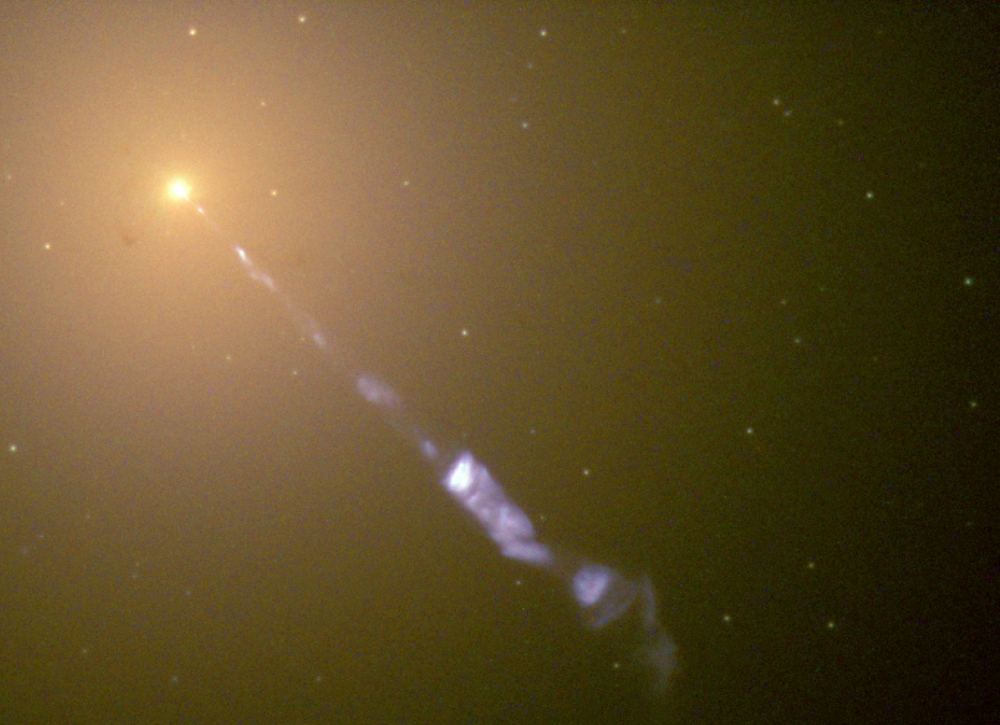Black holes are the one the most intriguing and awe-inspiring forces of nature. They are also one of the most mysterious because of the way the rules of conventional physics break down in their presence. Despite decades of research and observations there is still much we don’t know about them. In fact, until recently, astronomers had never seen an image of black hole and were unable to guage their mass.
However, a team of physicist from the Moscow Institute of Physics and Technology (MIPT) recently announced that they had devised a way to indirectly measure the mass of a black hole while also confirming its existence. In a recent study, they showed how they tested this method on the recently-imaged supermassive black hole at the center of the Messier 87 active galaxy.
The study appeared in the August issue of the Monthly Notices of the Royal Astronomical Society. In addition to researchers from the MIPT, the team included members from the Netherlands-based Joint Institute for VLBI ERIC (JIVE), the Academia Sinica’s Institute of Astronomy & Astrophysics in Taiwan, and the NOAJ’s Mizusawa VLBI Observatory in Japan.

For decades, astronomers have known that most massive galaxies have a supermassive black hole (SMBH) at their center. The presence of this SMBH leads to a considerable amount of activity in the core, where gas and dust fall into an accretion disk and accelerate to speeds that cause them to emit light, as well as radio, microwave, x-ray, and gamma-ray radiation.
For some galaxies, the amount of radiation produced by the core region is so bright that it actually overpowers the light coming from all the stars in its disk combined. These are known as Active Galactic Nuclei (AGN) galaxies since they have active cores and other galaxies are comparatively “quiet”. Another telltale identifier that a galaxy is active are the long beams of superheated matter that extend.
These “relativistic jets“, which can extend for millions of light-years outwards, are so-named because the material in them is accelerated to a fraction of the speed of light. While these jets are not fully understood just yet, the current consensus is that they are produced by a certain “motor effect” caused by a rapidly-spinning SMBH.
A good example of an active galaxy with a relativistic jet is Messier 87 (aka. Virgo A), a supergiant galaxy located in the direction of the Virgo Constellation. This galaxy is the closest active galaxy to Earth, and therefore one of the best-studied. Originally discovered in 1781 by Charles Messier (who mistook it for a nebula), it has been studied on a regular basis ever since. By 1918, its optical jet became the first of its kind to be observed.
Thanks to its proximity, astronomers have been able to study Messier 87’s jet meticulously – mapping its structure and plasma velocities and measuring temperatures and particle densities near the jet’s stream. The jet’s boundaries have been studied in fine detail that researchers discovered that it was homogenous along its length and changed shape the farther it extended (going from parabolic to conical).
All of these observations have allowed astronomers to test hypotheses regarding the structure of active galaxies and the relationship between changes in the jet’s shape and the influence of the black hole in the galactic nucleus. In this case, the international research team took advantage of this relationship and to determine the mass of M87s SMBH.
The team also relied on theoretical models that predict a jet’s break, which allowed them to create a model where an SMBH’s mass would accurately reproduce the observed shape of M87’s jet. By measuring the jet’s width and the distance between the core and the break of its shape, they also found that the M87’s jet boundary is made up of two segments with two distinctive curves.
In the end, the combination of theoretical models, observations and computer calculations allowed the team to obtain an indirect measurement of the black hole’s mass and spin rate. This study not only provides a new model for black hole estimation and a new means of measurement for jets but also confirms the hypotheses underlying the structure of jets

Essentially, the team’s results describe the jet as a flow of magnetized fluid, where the shape is determined by the electromagnetic field in it. This, in turn, is dependent things like the speed and charge of the jet particles, the electric current within the jet, and the rate at which the SMBH accretes matter from its surrounding disk.
The interplay between all these factors is what gives rise to the observed break in a jet’s shape, which can then be used to extrapolate the SMBHs mass and how fast it is spinning. Elena Nokhrina, the deputy head of the MIPT laboratory involved in the study and the lead author on the team’s paper, describes the method that they developed in the following way:
“The new independent method for estimation of black hole mass and spin is the key result of our work. Even though its accuracy is comparable to that of the existing methods, it has an advantage in that it brings us closer to the end goal. Namely, refining the parameters of the core ‘motor’ to deeper understand its nature.”
Thanks to the availability of sophisticated instruments for studying SMBHs (like the Event Horizon Telescope) and next-generation space telescopes that will be operational soon, it won’t take long for this new model to be thoroughly tested. A good candidate would be Sagittarius A*, the SMBH at the center of our galaxy that is estimated to be between 3.5 million 4.7 million Solar masses.
In addition to placing more accurate constraints on this mass, future observations could also determine just how active (or inactive) the nucleus of our galaxy is. These and other black hole mysteries await!


Anybody ever figure out that the rules of a blackhole breakdown because we never took the math far enough?